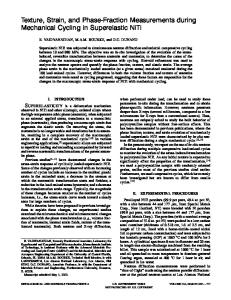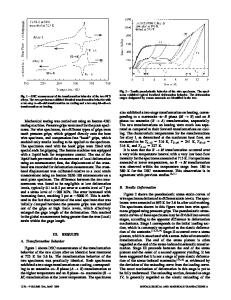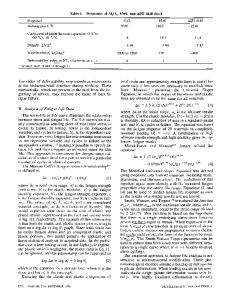Mean strain effects on the fatigue properties of superelastic NiTi
- PDF / 111,511 Bytes
- 4 Pages / 612 x 792 pts (letter) Page_size
- 22 Downloads / 351 Views
This work was partly supported by the POSCO. REFERENCES 1. J.J. Irani and R.W.K. Honeycomb: J. Iron Steel Inst., 1966, vol. 203, pp. 826-33. 2. D. Raynor, J.A. Whiteman, and R.W.K. Honeycomb: J. Iron Steel Inst., 1966, vol. 204, pp. 349-54. 3. A.T. Davenport and R.W.K. Honeycomb: Met. Sci., 1975, vol. 9, pp. 201-08. 4. M.K. Tseng, D.Y. Lee, and H.L. Marcus: Mater. Eng. Sci., 1983, vol. 60, pp. 73-77. 5. H. Kwon and C.H. Kim: Metall. Trans. A, 1983, vol. 14A, pp. 1389-94. 6. H. Kwon: Scripta Metall., 1989, vol. 23, pp. 1001-04. 7. H. Kwon: Metall. Trans. A, 1991, vol. 22A, pp. 1119-22. 8. K.B. Lee and H. Kwon: Scripta Metall. Mater., 1992, vol. 24, pp. 1355-60. 9. H. Kwon, K.B. Lee, H.R. Yang, J.B. Lee, and Y.S. Kim: Metall. Mater. Trans. A, 1997, vol 28A, pp. 775-84. 10. C.J. McMahon, Jr., A.K. Cianelli, and H.C. Feng: Metall. Trans. A, 1977, vol. 8A, pp. 1055-57. 11. J.I. Ustinovshchikov: Acta Metall., 1983, vol. 31, pp. 355-64.
Mean Strain Effects on the Fatigue Properties of Superelastic NiTi R.M. TABANLI, N.K. SIMHA, and B.T. BERG NiTi belongs to a class of materials called superelastic materials or shape-memory alloys. These alloys perform the largest amount of work per unit mass and per cycle and are capable of recovering strains as large as 6 pct in a reversible manner. Hence, they are ideal candidates for actuator and large-deformation biomedical applications. Predominantly, fatigue studies of superelastic materials[1,2,3] have obtained stress amplitude vs cycles-to-failure (S–N) curves and crack growth rates under completely reversed cyclic loading. However, as Miyazaki[4] argues, completely reversed loading is irrelevant to the superelastic working cycle. Hence, Miyazaki has measured S–N curves for loads that cycled between zero and a maximum stress.[4] The deformation corresponding to the low- and high-cycle fatigue was different; stressinduced transformation was observed in low-cycle fatigue,
R.M. TABANLI, Assistant Professor, is with the Faculty of Mechanical Engineering, Istanbul Technical University. N.K. SIMHA, Assistant Professor, is with the Department of Mechanical Engineering, University of Miami, Coral Gables, FL 33124-0624. B.T. BERG, Research Scientist, is with Scimed Life Systems, Inc., Minneapolis, MN 55311-1566. Manuscript submitted February 2, 2000. 1866—VOLUME 32A, JULY 2001
but not in high-cycle fatigue. This difference is also reflected in the S–N curves, where lines with different slopes are needed to fit the high-cycle and low-cycle data. The martensitic transformation is the basis of the superelastic and shape-memory properties. Yet, most existing studies do not explore the influence of the martensitic transformation on fatigue properties. The study by Miyazaki[4] shows that the martensitic transformation can influence the fatigue properties, but does not explicitly examine it. We propose to examine the influence of the martensitic transformation on the fatigue properties of NiTi by exploring meanstrain effects on the fatigue properties. Mean stress and mean-strain determine the ph
Data Loading...









